- Introduction to pharmacology
- What is a drug?
- What is in a drug?
- How do drugs work?
- Pharmacodynamics: What do drugs do to the body?
- Pharmacokinetics: What does the body do to drugs?
- Why do the effects of drugs vary between different people?
- Drugs during pregnancy
- Drugs while breastfeeding
- Over-the-counter medication
- Drug–drug interactions
- Assessing the risks and benefits of drugs
- Developing a pharmaceutical product
Introduction to pharmacology
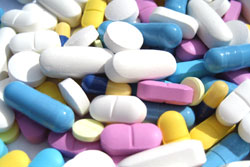
Everyone at one stage or another in life will rely on a pharmaceutical product, whether it is for themselves, a friend or a family member. Therefore it is useful to have a basic understanding of pharmacology.
What is a drug?
A drug is a chemical that interacts with proteins in the body to affect a physiological function. This is the general idea behind all medicine. Once these chemicals are absorbed into the systemic circulation they bind with certain proteins and this changes the functioning of the cell slightly. For example, anticancer drugs bind to proteins on the surface of cancer cells this stimulates the cells to die. In this case cell death is the physiological action of the drug.
No drugs are specific to interacting with just one type of cell or one type of protein and this is what causes side effects. Again using an anticancer drug as an example, the medication works by binding to very rapidly dividing cells, such as cancer cells, however hair cells are also rapidly dividing and that is why one of the side effects of anticancer drugs is hair loss.
What is in a drug?
The chemical in the drug that affects physiological functioning is the active ingredient of the drug. For most drugs, the amount of chemical needed to cause an effect is very small, often as small as 5 micrograms; this is 0.005% of a gram! As you can imagine this is too small to package and handle, these ingredients are very expensive and giving out little amounts like that will cause most of the drug to be lost and wasted. Therefore most of the drugs that we take are also comprised of inactive ingredients that work to fill out the drug. Inactive ingredients are, as the name suggests, ingredients that have no effect on the functioning of cells, namely lactose, dyes and gluten. If the drug needs to be taken orally, the inactive ingredients also work to bind the drug together and lubricate the drug so it is easy to swallow.
So the inactive ingredients are the fillers, binders and lubricants of the drug whereas the active ingredient is the very small amount of chemical that reacts with the body to produce an effect.
How do drugs work?
Our bodies are largely controlled by proteins. Proteins exist in many different forms in the body and have many different functions. Each protein has a specific function and is quite specific to the cell type that it acts on. For example, there are specific types of proteins called receptors. Receptors are embedded on the cell surfaces, there are different receptors for different types of cells. A liver cell will have different receptors than a cardiac cell. The receptor binds to other proteins and chemicals on the outside of the cell and this in turn creates a change in the functioning of the cell.
Proteins also act as drug targets. In order for a drug to exert an effect it needs to be bound to a protein. This can be thought of as a lock and key system; where the drugs are the key and the protein is the lock. Once the drug is bound in this lock and key mechanism it can have one of two main influences over the cell. It can produce a change in response or it can stop a normal response of the cell.
Drugs that produce a change in the cell functioning are called agonists. Drugs that stop a normal function of the cell are called antagonists.
Pharmacodynamics: What do drugs do to the body?
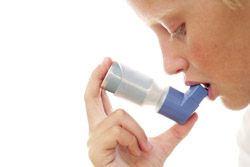
Pharmacokinetics: What happens to drugs in the body?
Pharmacokinetics is the study of what happens to drugs once they enter the body. The main stages include:
- The absorption of the drug into the blood and across cell membranes to enter the cells;
- The distribution of the drug throughout the body;
- The metabolism or breakdown of the drug; and
- The excretion of the drug from the body.
Each drug will have a unique bioavailability. This is the amount of drug available to have an effect on the biological system. A drug’s bioavailability is determined by its pharmacokinetics. For example, some drugs are poorly absorbed as they do not cross cell membranes as quickly or as effectively as others and so less of the drug will pass into the systemic circulation where it needs to be in order to have an effect.
The proportion of the drug that does pass into the circulation is called the drug-plasma concentration. When a drug is absorbed into the circulation, the plasma concentration will increase until it reaches a peak and then as the drug is metabolised this plasma concentration will decline until the entire drug has been metabolised and then excreted from the body. Depending on the characteristics of the drug some will reach the peak plasma concentration quicker than others or be metabolised faster and so on.
Each drug has a range of dosages that can effectively treat a condition while still remaining safe. That is, the range between the lowest dose that has a positive effect, and the highest dose before the negative effects outweigh the positive effects. This is known as the therapeutic window the drug. This can vary substantially between different types of drugs. For example, one drug could be safe and efficacious anywhere between 5mg to 20mg of whereas another could have the therapeutic window between 15mg and 20mg.
Why do the effects of drugs vary between different people?
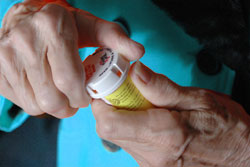
This variation is due mostly to differences in pharmacokinetics and pharmacodynamics between ethnicity, age, genetic makeup and disease state.
Ethnicity
There are quite substantial differences in drug metabolism between people of different ethnicities. Asians are usually more sensitive to most drugs than Caucasians and Caucasians are more sensitive then afro-carrabeans.
Age
Elimination of the drug from the body is directly influenced by age. Newborns and elderly experience the effects of drugs for longer and the drug takes a lot longer to be eliminated from the body.
Newborns
When babies are born to term, their renal function is very quick to establish similar levels to adults within one week after birth. If the baby is born prematurely it can take 8 weeks or more to reach the level of enzymes necessary. If drugs are given before the renal function is at this level, the drug elimination from the body takes a lot longer and so do the effects of the drugs.
Elderly
Renal filtration rate begins to decline at 20 years of age and by 50 years of age it has declined by 50%. This again will affect the elimination of drugs from the body.
Genes
The differences in our genes are also an important determinant of variability in what our bodies to do the drugs.
Disease state
There are many different disease states that affect pharmacokinetics. In fact most diseases will affect pharamcokinetics to some degree and this is for your doctor to determine and consider when prescribing medication. Diseases of the liver and kidneys will affect drug metabolism and excretion whereas diseases of the gastroenterological systems will affect the absorption of drugs. Receptors, the blood-brain barrier, blood, heart and skin are just some other areas that, if affected by disease, can impair the therapeutic action of drugs.
Drugs during pregnancy
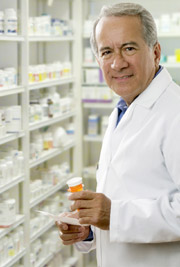
As a result, when a woman is pregnant their doctor has an especially difficult job in weighing up the risks versus benefits of prescribing a drug. Not only must the patient’s risk benefit be determined but also the risk for the developing foetus. Determining foetal risk from drug exposure is near impossible due to the lack of scientific data in the area.
That said, there is a list of drugs that are known to be harmful to a developing baby and these are called teratogens. Examples of these are alcohol and cigarette smoke. Teratogens must be strictly avoided during pregnancy. If you are in doubt as to whether a medication you are taking could be teratogenic always check with your doctor.
When weighing up the risks of prescribing medication the therapeutic decision is not the sole responsibility of the doctor but also the mother. Mothers will be made aware of the possible risks of the treatment and, through discussions with their doctor and family can decide for themselves whether they want to take the medication.
As a guide all drugs have been assigned a pregnancy category. The pregnancy categories describe the relative risk associated with the medication by summarising the information that is available to date. Each category puts into perspective the potential reliability of the information by describing the number of women that have been pregnant or of childbearing age that have taken the medication and the observable effects on the developing foetus. The categories provide an invaluable tool for weighing up the risk-benefit for doctors and patients.
Drugs while breastfeeding
Breastfeeding can expose a feeding child to toxicity due to the medication the mother is taking. The relative risk of toxicity through breast milk can be estimated by a doctor by weighing up the dose of the medication given, the amount from this that could be potentially excreted in breast milk and finally the potential dosage the infant will absorb systemically from the milk they ingest. Similar to the issue of medicating during pregnancy, large clinical trials have not been conducted in breastfeeding mothers and therefore the evidence is not available to support any certainty that the child will not be affected. If the mother needs to take medication which is known to be risky for children then the mother should not breastfeed her child.
Over-the-counter (OTC) medication
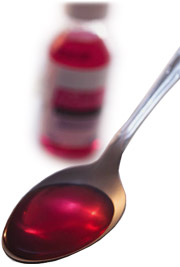
There are disadvantages involved with non-prescription medications. As OTC drugs do not require a doctor’s visit they have the potential to mask more serious medical issues. OTC drugs can also be associated with misuse and dependence.
Dependence on OTC medication is prevalent in society. The majority of consumers who do become dependent initially purchase OTC medication with the intention of treating a minor health issue but without proper guidance find it difficult to cease use of the drug. Only a small proportion of consumers purchase OTC with the intention to misuse the medication.
Before purchasing any over the counter medication it is advised that you speak to your pharmacist about the benefits, risks and appropriate use of the medication. Therefore it is wise that you purchase the medication from a community pharmacy rather than a supermarket.
e-pharmacies are online pharmacies where only non-prescription drugs can be purchased and delivered. Although this may seem like an easy option, a consumer cannot be sure they are receiving all the information they need in order to make an informed decision about whether to take the drug or whether further information is required. While some internet sites provide very accurate and comprehensive information there are some that provide poor quality information and do not identify possible drug interactions. Most OTC drugs are safe to use when used properly however it is always best to speak to your pharmacist or trained pharmacy assistant about dosing, drug interactions and other options.
An important point to note is that medications need to be suited to the individual, this is the area that pharmacists and doctors are trained to assess. When in doubt always ask a trained healthcare professional.
Drug–drug interactions
Polypharmacy is the use of multiple drugs at once for different reasons. This occurs most frequently in the elderly who need to take many different types of drugs a day. Drugs can be affected by the pharmacodynamics or pharmacokinetics of the other drug. For example a pharmacodynamic reaction would be if drug X works to decrease heart rate it may affect the distribution of drug Y due to the decrease in blood pressure. A pharmacokinetic reaction would be if both drugs are metabolised in the liver and therefore need to compete with the metabolisation enzymes.
Assessing the risks and benefits of drugs
The side effects associated with some medications are more detrimental than the disease state they are treating. It is in these situations when you and your doctor must work together to determine the risk and benefit profile of taking the medication. In order to completely determine the risks you MUST tell your doctor which medications you are taking concomitantly, including herbal supplements, any allergies you have and any previous adverse effects you have experienced from medication.
Make sure you are aware of all the medications you are taking, what they are for and the risks associated with each. If the side effects are severe you may not want to continue with the treatment. Ask your doctor if there are any alternatives and if not discuss the consequences of not taking the medication. However, never stop a medication without the advice of your doctor.
Developing a pharmaceutical product
Developing pharmaceutical products is an extremely expensive and long process, costing billions of dollars and taking over a decade to produce one drug! There are three main stages in the drug development process. These are:
- Laboratory methods: this includes testing the newly formed/discovered molecule on cell cultures (these are cells in dishes in labs not within living organisms) and then animals (usually either rats or mice).
- Clinical trials: firstly on healthy human volunteers then moving onto patients undergoing medical treatment.
- Socioeconomic methods: assessment of the drug in the community, the adverse effects, the family of the patient’s response, the healthcare costs etc.
Each stage of the process must pass strict safety and efficacy testing before the medicine can progress. Throughout all stages the scientists are determining the benefits versus risks of the new drug. For every drug there will be side effects and adverse effects in some patients. In order to determine whether the drug will have an overall benefit, the proportion of patients that respond positively to the treatment must be compared to the number of patients that respond negatively. So for example in a clinical trial sample of 1000 patients, if 996 patients experience a significant improvement in quality of life and 4 patients experience an adverse drug reaction, more than likely the benefit outweighs the risk in this case. If 550 patients significantly improve and 450 patients experience adverse drug reactions the drug is not likely to be marketed. This of course depends on the nature and severity of the adverse events.
Once the drug has been determined to be safe, effective and a significant cost-benefit it may be produced, marketed and distributed to the public. In Australia, the authority that makes the overruling decision is the Therapeutic Goods Administration (TGA).
References
- Rang HP, Dale MM, Ritter JM, et al. Pharmacology (5th edition). London: Elsevier Science; 2003.
- Vadja FJE. Generic substitution in epilepsy: A controversial issue [online]. The Epilepsy Report; 2006. [cited March 2009]. Available from: [URL link]
- Jones AW, Holmgren A, Kugelberg FC. Concentrations of scheduled prescription drugs in blood of impaired drivers: considerations for interpreting the results. Therapeutic Drug Monitoring. 2007; 29(2):248-60.
- Xie HG, Frueh FW. Pharmacogenomics steps toward personalised medicine. Personalized Medicine. 2005; 2(4): 325- 37.
- Bloche G. Race-based therapeutics. N Engl J Med. 2004: 351(20): 2035-7.
- Camí J, Farré M. Mechanisms of disease: Drug addiction. N Engl J Med 2003; 349:975-86.
- Briggs GG, Freeman RK, Yaffe S. Drugs in Pregnancy and Lactation: A Reference Guide to Fetal and Neonatal Risk (8th edition). Philadelphia: Lippincott Williams & Wilkins; 2008.
- Bedouch P, Allenet B, Grass A,et al. Drug-related problems in medical wards with a computerized physician order entry system. Journal of Clinical Pharmacy and Therapeutics. 2009; 34: 187-95.
- McBride AJ, Pates R, Ramadan R, et al. Delphi survey of experts’ opinions on strategies used by community pharmacists to reduce over-the-counter drug misuse. Addiction. 2003; 98(4):487-97.
- Bessell TL, Anderson JN, Silagy CA, et al. Surfing, self-medicating and safety: buying non-prescription and complementary medicines via the internet. Quality & Safety in Health Care. 2003; 12(2):88-92.
All content and media on the HealthEngine Blog is created and published online for informational purposes only. It is not intended to be a substitute for professional medical advice and should not be relied on as health or personal advice. Always seek the guidance of your doctor or other qualified health professional with any questions you may have regarding your health or a medical condition. Never disregard the advice of a medical professional, or delay in seeking it because of something you have read on this Website. If you think you may have a medical emergency, call your doctor, go to the nearest hospital emergency department, or call the emergency services immediately.







